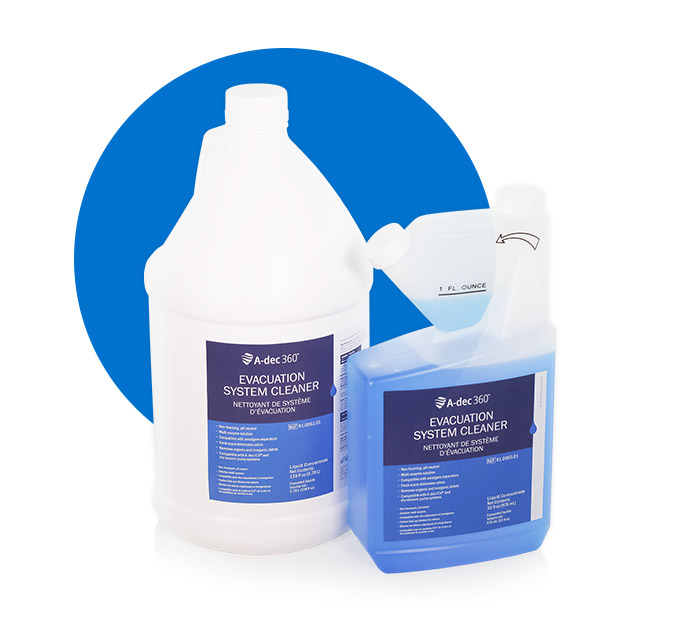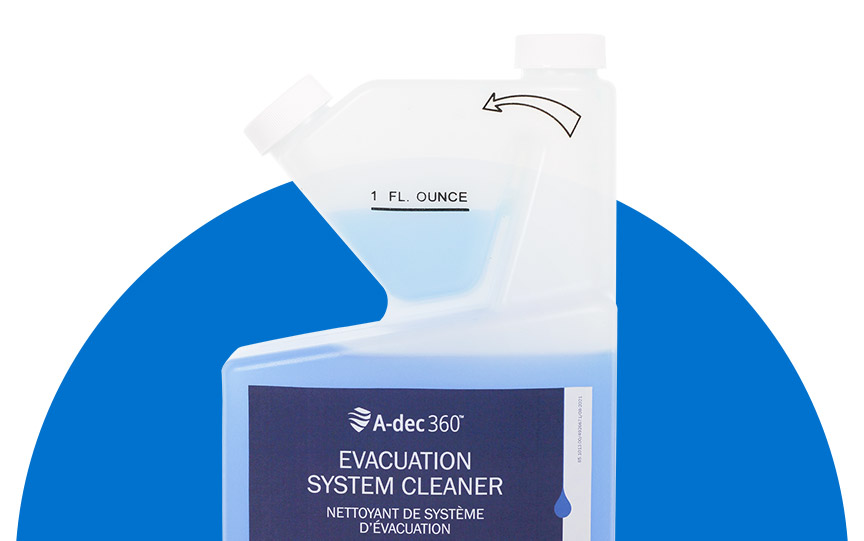A-dec Evacuation System Cleaner
Maximize your vacuum performance
A vacuum pump is at the core of a dental practice. Keep it running at peak performance—and avoid costly repairs and downtime—with A-dec Evacuation System Cleaner. A-dec’s unique, easy-to-use, multi-enzyme solution is specifically formulated to dissolve and remove organic and inorganic debris that may build up over time.

Free sample
Request your free sample of A-dec Evacuation System Cleaner.
Samples available for U.S. customers only.
A-dec Evacuation System Cleaner features
- Multi-enzyme solution
- Non-foaming, pH neutral
- Compatible with amalgam separators
- Removes organic and inorganic debris
- Fresh scent eliminates odors
- Compatible with A-dec vacuum pump and ICV vacuum line cleaning system

To order A-dec Evacuation System Cleaner, contact your local A-dec dealer.
How to use A-dec’s Evacuation System Cleaner
Watch step-by-step instructions on how to use the A-dec Evacuation System Cleaner.
How frequently should vacuum lines be cleaned?
At a minimum, vacuum lines should be cleaned every day. More frequent cleaning will depend on the office's infection control protocols.
Can a customer use an atomizer to apply the A-dec Evacuation System Cleaner if they do not have an A-dec ICV vacuum-line cleaning system?
Yes, customers may use their existing atomizer to apply the A-dec Evacuation System Cleaner. The amount of cleaner needed will depend on the size of the atomizer. Please refer to the instructions for use found on the A-dec Evacuation System Cleaner bottle for the volume of concentrate needed based on the size of the atomizer.
Can the A-dec ICV vacuum-line cleaning system be used to apply the Evacuation System Cleaner?
Yes. The amount of Evacuation System Cleaner to be used depends on the size of your ICV tank. Please see the following table. Using the table below, mix the quantity of concentrate with the volume of warm water for the size of your atomizer or ICV tank. This information is also found in the instructions for use printed on each bottle.
| ICV tank size | 5 litre/1.32 gal | 8 litre/2.11 gal |
|---|---|---|
| Concentrate | 5 oz/150 mL | 8 oz/240 mL |
Are there differences between vacuum line cleaners?
Yes, vacuum line cleaning product products vary in formulation and composition of chemicals used including surfactants, enzymes or microbes, acids, salts, or mixtures of several chemicals serving different functions including organic deposit removal, breakdown of sludge, or scale removal.
Do all non-foaming and low-foaming cleaners prevent foaming?
No, some products advertised as either non-foaming or low foaming can produce enough foam to penetrate the pump's impellers thus increasing the chance of damaging the pump. The A-dec Evacuation System Cleaner has been tested to be fully compatible with A-dec dry vacuum pumps when used properly.
Why should we use an enzymatic cleaner?
Enzymatic cleaners speed up the breakdown of soils and are especially useful in vacuum lines where no mechanical scrubbing can take place. Enzymes are more effective at quickly breaking down proteins, carbohydrates, and fatty soils from blood and mucous deposits. Detergents can take much longer to loosen and remove contaminants and may not be able to maintain vacuum line contamination when blood and mucus are deposited continuously.
Is the A-dec Evacuation System Cleaner a non-foaming, enzymatic cleaner?
The A-dec Evacuation System Cleaner is an enzymatic cleaner that contains a small amount of surfactant. This surfactant will generate a small amount of foam needed to aspirate the solution, so it thoroughly coats the walls of the vacuum lines and aid in the removal of materials from the vacuum line. The foam dissipates quickly before it reaches the pump's separation tank. Consequently, the solution is considered non-foaming.
Should vacuum lines be flushed after every oral surgery procedure?
Each clinic will need to determine the appropriate infection control protocols for post-procedural reprocessing including cleaning and disinfection. Higher blood and soil loads that may result from oral surgical procedures would likely require more frequent cleaner applications.
